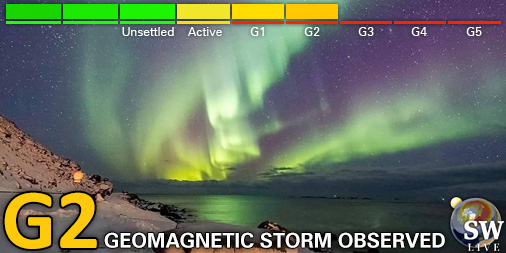Viewing archive of Friday, 16 February 2018
Daily bulletin on solar and geomagnetic activity from the SIDC
Issued: 2018 Feb 16 1230 UTC
SIDC Forecast
Solar flares
Quiet conditions (<50% probability of C-class flares)
Geomagnetism
Active conditions expected (A>=20 or K=4)
Solar protons
Quiet
| 10cm flux | Ap | |
|---|---|---|
| 16 Feb 2018 | 073 | 015 |
| 17 Feb 2018 | 072 | 016 |
| 18 Feb 2018 | 071 | 010 |
Bulletin
Over the past 24 hours solar activity has been low. No significant flares have been recorded. Active Region (AR) 2699 (Mcintosh class:Cao; Mag. type:Beta) has been most active, showing considerable flux emergence and cancellation, but is now approaching the western limb. The greater than 10MeV proton flux remained at background levels over the past 24 hours. No Earth directed Coronal Mass Ejections (CMEs) have been detected. Over the next 24 hours there is a small chance of C-class flares. The solar wind speed fluctuated around 375 km/s over the past 24 hours. The total magnetic field strength has increased from around 5 nT to 15 nT, the Bz component has fluctuated between -5 and +15 nT. Geomagnetic conditions ranged between Kp index 1-4 (NOAA) and local K index 1-4 (Dourbes) over the past 24 hours. A High Speed Stream (HSS) associated with a large coronal hole that passed the central meridian a couple of days ago may enhance solar wind conditions over the next couple of days. Geomagnetic conditions are expected to be quiet to unsettled.
Today's estimated international sunspot number (ISN): 013, based on 19 stations.Solar indices for 15 Feb 2018
| Wolf number Catania | /// |
| 10cm solar flux | 073 |
| AK Chambon La Forêt | 026 |
| AK Wingst | 020 |
| Estimated Ap | 018 |
| Estimated international sunspot number | 017 - Based on 22 stations |
Noticeable events summary
| Day | Begin | Max | End | Loc | Strength | OP | 10cm | Catania/NOAA | Radio burst types | |
|---|---|---|---|---|---|---|---|---|---|---|
| None | ||||||||||
Provided by the Solar Influences Data analysis Center© - SIDC - Processed by SpaceWeatherLive
All times in UTC
Current data suggests there is a moderate possibility for aurora to appear at the following middle latitude regions in the near future
Surgut, SyktyvkarCurrent data suggests there is a slight possibility for aurora to appear at the following middle latitude regions in the near future
Moscow, Perm, YaroslavlLatest news
Latest forum messages
Support SpaceWeatherLive.com!
A lot of people come to SpaceWeatherLive to follow the Sun's activity or if there is aurora to be seen, but with more traffic comes higher server costs. Consider a donation if you enjoy SpaceWeatherLive so we can keep the website online!

Latest alerts
17:00 UTC - Geomagnetic activity
Moderate G2 geomagnetic storm (Kp6) Threshold Reached: 16:34 UTC
15:30 UTC - Geomagnetic activity
Minor G1 geomagnetic storm (Kp5) Threshold Reached: 15:20 UTC
14:30 UTC - Geomagnetic activity
Strong G3 geomagnetic storm (Kp7) Threshold Reached: 14:18 UTC
13:30 UTC - Geomagnetic activity
Moderate G2 geomagnetic storm (Kp6) Threshold Reached: 13:21 UTC
13:18 UTC - Hemispheric Power Index
The OVATION model predicts the Hemispheric Power Index to reach 125GW at 14:01 UTC
Space weather facts
| Last X-flare | 2025/03/28 | X1.1 |
| Last M-flare | 2025/04/15 | M1.2 |
| Last geomagnetic storm | 2025/04/15 | Kp6+ (G2) |
| Spotless days | |
|---|---|
| Last spotless day | 2022/06/08 |
| Monthly mean Sunspot Number | |
|---|---|
| March 2025 | 134.2 -20.4 |
| April 2025 | 124.1 -10.1 |
| Last 30 days | 124.7 -16.6 |






